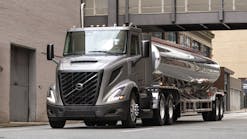Conventional wisdom holds that tank trailers are inherently more aerodynamic than many other types of trailers — particularly vans. However, that's not to say tank trailers couldn't stand some improvement, especially when it can improve the fuel economy of a tanker tractor-trailer rig.
Brenner Tank LLC and Walker Stainless Equipment Co launched a project more than a year ago to explore ways to enhance the aerodynamic efficiency of tank trailers. Nick Paulick, Brenner director of engineering, provided an update on the project during the National Tank Truck Carriers 2008 Cargo Tank Maintenance Seminar in Louisville, Kentucky.
In developing the project, Brenner and Walker commissioned wind tunnel tests at Georgia Tech Research Institute and partnered with Richard Woods, president of SOLUS-Solutions and Technologies LLC and a former National Aerodynamics and Space Administration aerodynamics engineer. More than a dozen potential aerodynamic enhancements were researched.
“Our objective with our AeroTank project was to improve the aerodynamics of tank trailers and try to reduce operating costs to a level comparable with rail,” Paulick said. “Studies show that aerodynamic factors have the single biggest impact on fuel economy. Tractor aerodynamics has been significantly improved over the past couple of decades, but tank trailer design has remained relatively static.”
Brenner and Walker built three test trailers with a first-generation version of the AeroTank system. Fleets are now running these trailers in over-the-road operations to gather real-world data on the effectiveness of the aerodynamic treatment.
“We're looking at driver acceptance and maintenance issues,” Paulick said. “We want to know how vehicle inspections will be affected. This is a safety factor that must be addressed in the testing. We know that there will be an impact, but we need to know how much.”
The AeroTank package includes side skirts that can be fabricated from aluminum or stainless steel. The aluminum skirting will add about 500 pounds to trailer weight, and the stainless steel will be heavier.
“We are projecting a 5%-plus improvement in fuel economy at speeds over 50 miles per hour,” Paulick said. “Our research models suggest that tank owners will be able to recoup the investment in the aerodynamic system in 12 to 24 months.”
Drag reduction
In developing the aerodynamic treatment, Brenner and Walker focused on drag reduction because air-flow management offered the biggest opportunity for improvement. The most drag comes from the tank underside (30%), tank rear (20%), and overall trailer roughness (>15%) as a result of ladders, domelids, overturn protection, and other hardware. The tank nose contributes less than 10% of the total drag.
Even with all of those drag factors, a tank trailer offers 66% less drag area than a van trailer. Aerodynamic treatments bring smaller improvements for tank trailers, and that is why vehicle engineers concentrated more on improving van trailer aerodynamics in the past.
However, the current economic problems are prompting tank fleets and their equipment suppliers to aggressively explore ways to reduce operating costs. Improved aerodynamics certainly can contribute to greater operating efficiency. “Our studies show that our system will provide up to 19% fuel savings,” Paulick said.
Brenner and Walker followed a systematic approach in measuring drag reduction. Ladders, hose carriers, spill dams, and other tank systems got plenty of attention. Engineers looked at ways to reduce the drag effect of various components, and they researched the best ways to redirect airflow around the trailer.
Part of the research was done with scale models in a wind tunnel, but the engineering team also relied on real-world testing. In fact, the real-world evaluation will continue for quite some time to come. Controlled testing using Society of Automotive Engineers methodology also will be conducted.
Paulick added that future studies may look at ways to optimize tractor aerodynamics for tanker applications. “It's something we still need to examine,” he said. “Current tractor aerodynamics are optimized for van trailer applications.”
Most, but not all, tank trailer operators can benefit from improved aerodynamics, according to Paulick. Chemical and foodgrade tanks are well suited to the system offered by Brenner and Walker. Petroleum trailers are very dirty aerodynamically, but they also may be the most difficult to improve due to all the product handling hardware.








